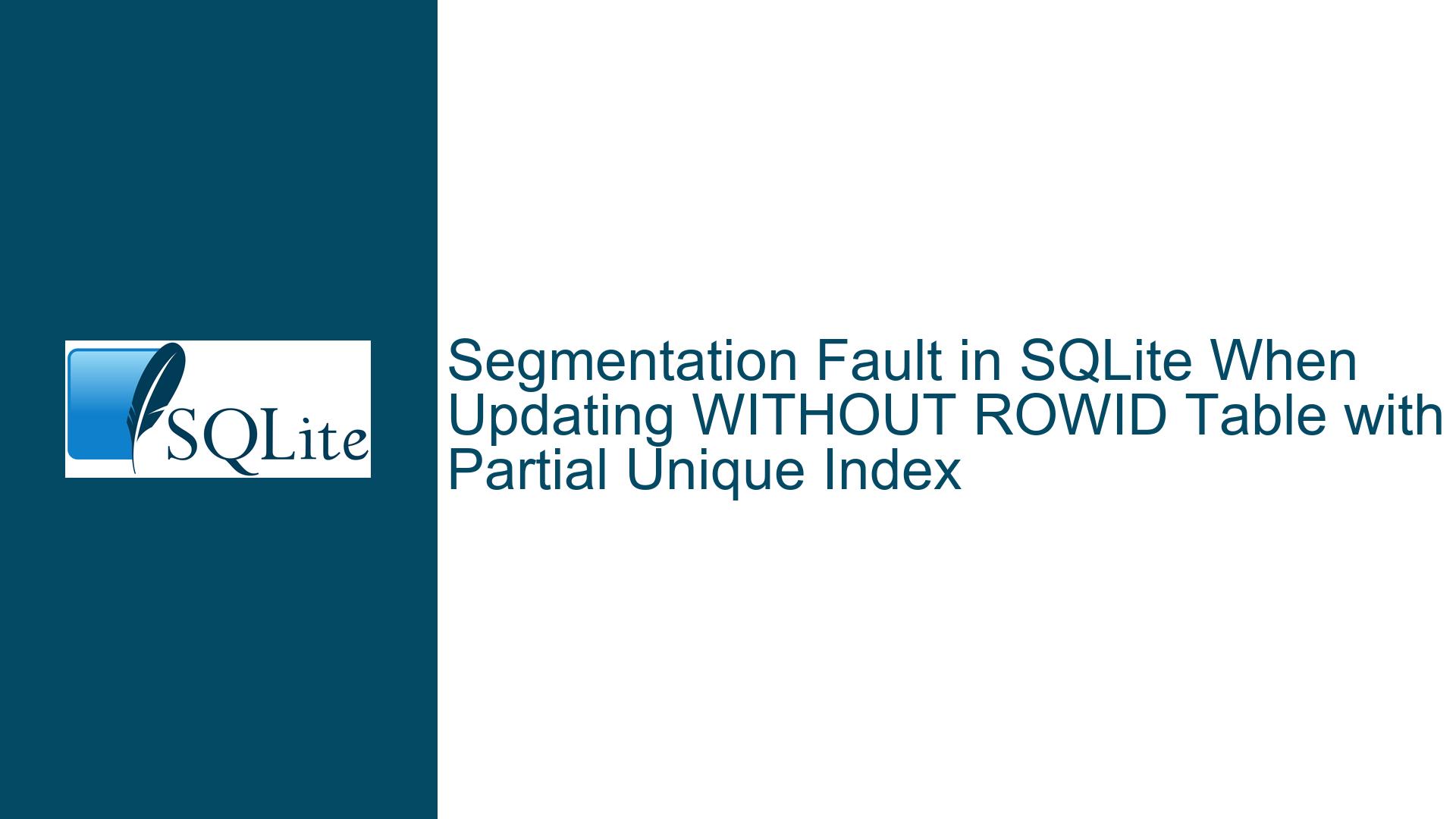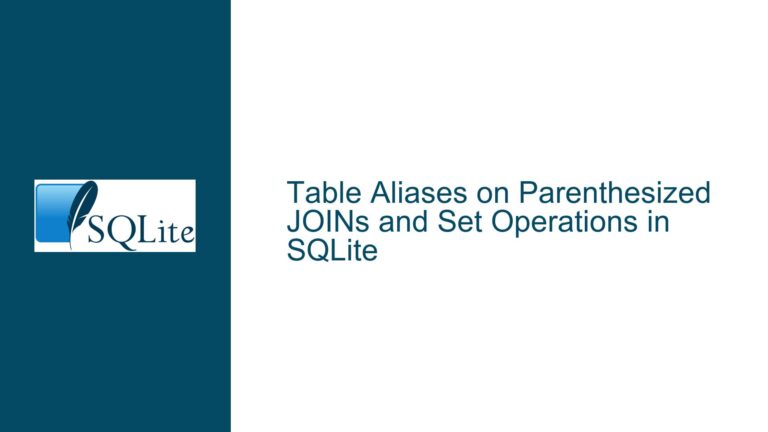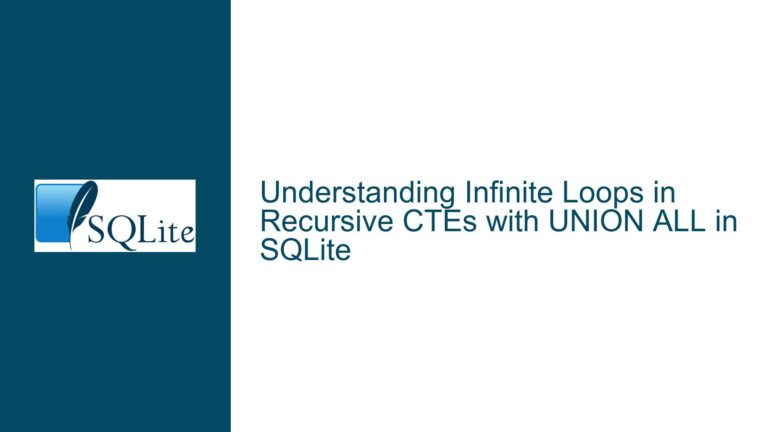Segmentation Fault in SQLite When Updating WITHOUT ROWID Table with Partial Unique Index
Crash Triggers: Parameterized UPDATE Queries on WITHOUT ROWID Tables with Partial Unique Indexes
Anatomy of the Fault: Execution Contexts and Index Management
The core issue arises when executing an UPDATE query that modifies the primary key of a WITHOUT ROWID table with a partial unique index defined using a WHERE clause. The crash occurs under the following conditions:
- The table uses
WITHOUT ROWIDand has an explicitPRIMARY KEY. - A
UNIQUEpartial index exists with a conditional filter (e.g.,WHERE Type=1). - The
UPDATEoperation uses bound parameters (?1,?2) to specify values in theWHEREclause.
The crash manifests as a segmentation fault due to a null pointer dereference in the SQLite Virtual Database Engine (VDBE). The fault occurs during index maintenance operations when the VDBE attempts to access a cursor (VdbeCursor *pC) that has not been properly initialized.
Key Technical Observations:
- The
EXPLAINoutput reveals aColumnopcode (address 9) attempting to read from cursor 4, which is associated with the partial indexType1Unique. - The debugger stack trace shows
pC(a cursor pointer) is0x0(null) at the point of failure. - The crash occurs during the
UPDATEoperation’s index maintenance phase, specifically when the VDBE processes the partial unique index’s constraints.
Reproduction Flow:
- Schema Creation: The
Reprotable is defined with a composite primary key (ID), aTypecolumn, and aValcolumn. TheWITHOUT ROWIDclause forces the primary key to act as the row’s storage key. - Partial Unique Index: The
Type1Uniqueindex enforces uniqueness on theValcolumn only for rows whereType=1. This creates a conditional uniqueness constraint. - Parameterized UPDATE: The
UPDATEstatement modifies theID(the primary key) of a row that matches theType=?1 AND Val=?2condition. Parameters?1and?2are bound to1and2, respectively.
Failure Modes:
- The crash does not occur if:
- The
UPDATEuses literal values instead of parameters. - The
WITHOUT ROWIDclause is removed. - The partial index is made non-unique.
- The
- The interaction of these three components (parameters,
WITHOUT ROWID, partial unique index) creates an edge case where the VDBE’s cursor management logic fails to initialize a cursor for index traversal.
Underlying Mechanisms: Cursor Initialization and Partial Index Validation
The crash is rooted in how SQLite’s query planner and VDBE coordinate to enforce uniqueness constraints during updates to WITHOUT ROWID tables. Below are the critical mechanisms at play:
Cursor Management in VDBE:
- During an
UPDATE, SQLite uses cursors to iterate over indexes and validate constraints. - The partial index
Type1Uniquerequires the VDBE to open a cursor (OpenReadat address 3 inEXPLAIN) to scan for potential uniqueness violations. - In the failing case, the cursor associated with the partial index is not properly initialized, leading to a null pointer dereference.
- During an
Parameter Binding and Query Optimization:
- Bound parameters force the query planner to delay some optimizations until runtime.
- The
WHERE Type=?1 AND Val=?2clause interacts with the partial index’sWHERE Type=1condition. When?1is bound to1, the planner should leverage the partial index for efficient lookups. - A misoptimization occurs when the planner assumes the partial index’s cursor is already valid, skipping initialization steps.
Primary Key Modification in WITHOUT ROWID Tables:
- Changing the
ID(primary key) in aWITHOUT ROWIDtable requires rewriting the entire row, as the primary key is the storage key. - This operation triggers a delete-and-reinsert workflow, which must update all associated indexes.
- The partial unique index’s conditional logic introduces a race condition: the VDBE attempts to validate uniqueness before the old row is deleted, leading to cursor misalignment.
- Changing the
Code-Level Analysis:
- The crash occurs at
sqlite3VdbeExecinvdbe.c, wherepC = p->apCsr[pOp->p1]dereferences a null cursor. - The
EXPLAINoutput shows that cursor 4 (associated withType1Unique) is opened at address 3 but is not correctly referenced during theColumnoperation at address 9. - The patch referenced in the discussion (7058d93b) addresses this by ensuring cursors for partial indexes are initialized before use.
Resolution Pathways: Workarounds, Patches, and Schema Adjustments
Immediate Workarounds:
Avoid Parameterized Queries: Replace
?1and?2with literals:UPDATE Repro SET ID=0 WHERE Type=1 AND Val=2;This bypasses the query planner’s delayed cursor initialization.
Remove WITHOUT ROWID: Redefine the table as a standard rowid table:
CREATE TABLE Repro (ID INTEGER NOT NULL PRIMARY KEY, Type INTEGER NOT NULL, Val INTEGER);Rowid tables handle primary key updates differently, avoiding the cursor issue.
Drop the UNIQUE Constraint: Convert the index to non-unique:
CREATE INDEX Type1Unique ON Repro (Val) WHERE Type=1;This eliminates the uniqueness enforcement that triggers cursor validation.
Long-Term Fixes:
Apply the SQLite Patch: Integrate the fix from check-in 7058d93b into your SQLite build. This patch ensures cursors for partial indexes are initialized during parameterized updates.
Upgrade to a Future Stable Release: Monitor SQLite’s release notes for versions post-3.44.0, as the fix will be included in subsequent releases.
Schema Design Considerations:
- Avoid Partial Unique Indexes on WITHOUT ROWID Tables: If possible, enforce uniqueness at the application layer or via triggers.
- Use Composite Primary Keys: If the
IDcolumn does not require modification, consider making(ID, Type)the primary key to reduce index complexity.
Verification Steps:
Confirm SQLite Version:
SELECT sqlite_version();Ensure the version is 3.44.0 or newer if testing the patch.
Test with EXPLAIN QUERY PLAN:
EXPLAIN QUERY PLAN UPDATE Repro SET ID=0 WHERE Type=?1 AND Val=?2;Validate that the query planner uses the partial index correctly.
Developer Notes:
- Rebuild SQLite with debugging symbols to capture detailed stack traces.
- Use
PRAGMA integrity_check;after updates to detect index corruption caused by cursor errors.
Anticipated Fix Behavior:
The patch modifies cursor initialization logic to account for partial indexes during updates. After applying it, the VDBE will:
- Open cursors for all relevant indexes before processing row updates.
- Validate uniqueness constraints using properly initialized cursors.
- Avoid null pointer dereferences by ensuring
pCreferences valid cursors.
Monitoring and Mitigation:
- Subscribe to SQLite’s mailing list for announcements about the fix’s inclusion in stable releases.
- Implement automated crash reporting in embedded deployments to detect similar issues early.
This guide provides a comprehensive pathway to diagnose, mitigate, and resolve the segmentation fault caused by parameterized updates on WITHOUT ROWID tables with partial unique indexes. By addressing cursor initialization logic and schema design choices, developers can stabilize their SQLite deployments against this edge case.






